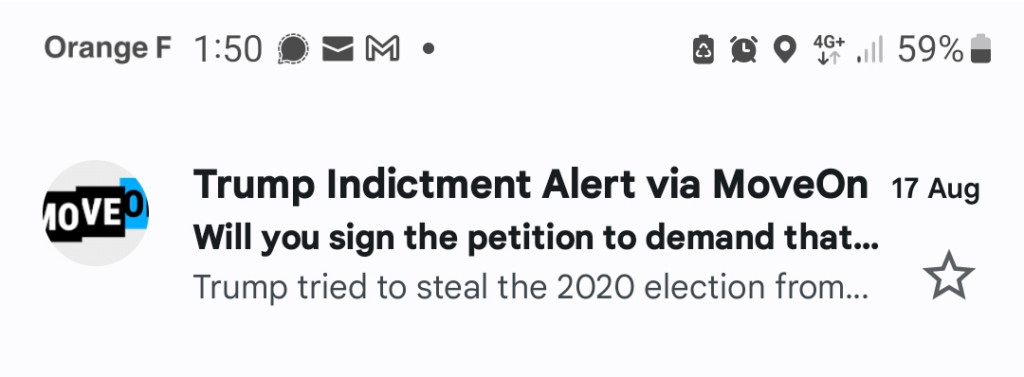Email is the king of digital direct response fundraising. If you consistently grow your email list and engage and solicit it well, you’ll enjoy a steady growth in digital fundraising revenue.
Of course, your emails can only earn donations if people open them. That sounds simple enough, but with your subscribers receiving 120 emails per day on average (including spam), there’s a lot of competition in their inboxes.
In this environment, only a few emails will get opened. And of the factors that can make an email compelling, the subject line is arguably the most important. It gets viewed in all email clients and situations and it affords you – and your inbox competitors – great creative flexibility.
What makes a successful email subject line?
There’s more than one way to write a good subject line. Here we break down a number of characteristics and tactics that can make your subject line stand out – along with examples from my personal inbox. You don’t need to use them all in all your subject lines. Rather, you should choose tactics that align best with each campaign and topic, and test different approaches over time and within your campaigns.
Relevance
If your reader perceives your email as immediately relevant to themselves, you’ve got a great chance of it getting opened.
A topic can be relevant for a range of reasons. For example, it may be a natural emergency or a shocking story in the news right now, making people highly aware and engaged in it. Like this one I received during the disastrous Australian bushfires in 2020:
James, Australia is burning – here’s how you can help
Or your audience may have personal experience related to the topic, for example having a partner with a specific health condition:
Simple test for dementia on the horizon
A topic may be relevant because it triggers values shared by a lot of your audience, like the need to protect children. Or it may offer something of value – the “what’s in it for me” factor – be that a physical reward or something less tangible:
Ready for movie night? Check out our movie list
If your story isn’t immediately relevant to the reader, there are other tactics you can use to make your subject line compelling all the same. At the top of the list is intrigue.
Intrigue
An intriguing subject line arouses the curiosity of the reader, making them want to click through to find out more. There are a couple of common ways subject lines create intrigue.
First, the line may be cryptic, meaning that the message is obscure, but it piques curiosity.
Or the subject line may raise a question or an unfinished story that requires the reader to open the email to resolve.
James: Something’s burning
Intrigue can be a great approach, but beware of wading into “clickbait” territory. A clickbait line generally gets the viewer to click through on something using misleading or exaggerated language.
To intrigue well, your subject line should still align with the content of the email so your supporter doesn’t feel deceived when they open it. They may feel surprised or enlightened, but avoid deceit. This is a fine line to walk, so take care.
Urgency or timeliness
Fundraisers are no strangers to urgency. Conveying a strong sense that something’s urgent or happening right now is a great way to increase a subject line’s strength and get a response.
Emergency: Act now for aid to Sudan
Breaking: Yulin Slaughterhouse Rescue
Use this tactic sparingly, just when it’s appropriate. Overdo it and you’ll be perceived as the email equivalent of the boy who cried wolf.
Fun
Employing fun or humor is another great way to stand out in an inbox. Make people smile or laugh, and they’re more likely to opt for your email before all the serious natured competition in their inbox, like this one from an animal welfare charity:
James, meow’s the time
Brevity
A short subject line is both easier to compute and less likely to be truncated when space is restricted in email clients.
FW: Koala habitat destroyed
On the other hand, check out the following example from my Gmail inbox viewed on a mobile device. The topic is not fully evident from the subject line, although the preview text does at least tell me it’s about Donald Trump.

Keep things brief and to the point, and front-load keywords in your subject lines if they need to be a little longer.
Personalization
If done well, personalization can warm up your subject line, making it feel more conversational and intimate. The easiest and briefest data to personalize is the first name. Although you could also use something instantly recognizable like the subscriber’s town, or the name of their team in a peer-to-peer event they took part in.
Keep in mind that extra words equal extra space that might bump your subject line outside the visible limits of your donor’s email client, like in the following example. Try to front-load relevant keywords so your supporters at least know what it’s about if they can’t see the whole thing.
 Emojis
Emojis
Using emojis to add a visual element to your subject line can make it stand out in your inbox, as in this example:
🌊 Ocean updates you might have missed!
The appetite for emojis definitely does depend on the audience. Older demographics and men are generally less inclined to use them. But it’s also true to say that emojis are becoming a more universal feature of digital communications every year. Just be careful to use emojis that will be clear to your audience. As experts in this article explain, different generations sometimes attribute different meanings to certain emojis.
Avoid “spammy” words
Email service providers (ESPs) protect you from malware and scams from bad actors by identifying their emails and sending them to your Spam folder. The ESPs use algorithms that account for a range of factors in identifying spam, and one of those factors is the use of certain keywords. It’s best that you avoid these words in your subject lines.
HubSpot maintains an ultimate list of spam trigger terms that you can refer to, and there are several other reliable sources if you want to cross-reference.
Test
My last piece of advice regarding subject lines is to always test them (unless you choose to split test another element like an image or email copy). Subject line tests are one of the easiest to run on most email platforms. Come up with a couple of different approaches based on the tactics above and your previous learnings and test them against each other.
Of course, as with all testing, you need to be aware of cohort sizes and significance. If you’ve only got a few hundred email subscribers, you’re probably not going to get a significant test result.
Also, be aware that email test reporting – and engagement reporting in general – is becoming less reliable due to the impact of privacy technologies like Apple’s Mail Privacy Performance. This doesn’t mean there’s no point in A/B testing. But you may want to shift to clicks as your primary metric, or if possible, test with segments excluding Apple Mail clients before rolling out the result to your whole audience.
Regardless of the changing state of email reporting, a good subject line is a good subject line. Be a critical observer of what other organisations are doing and experiment with the tactics above to master better engagement with your audience and get more of them to open your emails.
Want more up-to-the-moment help for digital fundraising? Take our all-new and completely FREE online workshop, 3 Email Fundraising Mistakes That Cost You Tons of Donations. Featuring digital Fundraisingologist James Herlihy, this single session will help you leap forward in your online fundraising mastery. Sessions are coming up soon! More information here.
Related Blog Posts:











